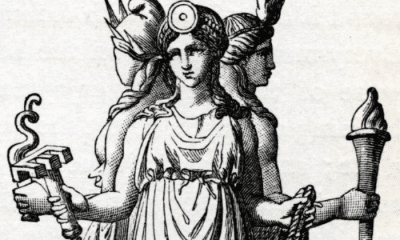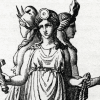Greek
Who Was Hades’ Daughter?
Did you know the god of the dead had children? While most Greeks did not believe this was possible, one group of believers created a vivid image of Hades’ daughter.
A secretive group in Greek culture believed that they knew why dogs barked in the night and shadows seemed to move on their own. Late at night, they believed, Hades’ daughter led the ghosts out of the Underworld.
Melinoe led a spectral retinue of restless spirits. Wronged by the living, they sought vengeance by spreading fear and madness.
Melinoe was not universally feared, however.
Many Greek people likely did not believe in her, or even know about her, at all. Those that did believed that she had a kindly side that was focused on justice.
Hades’ daughter is an unusual and little-known figure of Greek mythology who is unique because of the people who believed in her.
Hades’ Daughter Melinoe
Many Greeks believed that Hades, the ruler of the realm of the dead, had no children of his own. As a lord of dead things, he was incapable of creating new life.
Some traditions, however, believed otherwise. They named several deities, some not recognized elsewhere in Greek religion, that were supposedly born to the king and queen of the Underworld.
One of these was Melinoe, Persephone and Hades’ daughter.
Because of her parentage, Melinoe was closely associated with the dead. She was the goddess of propitiation.
Propitiation is the act of appeasing or appealing to the spirits of the dead. The Greeks believed that by offering libations, visiting graves, and otherwise honoring their dead, they would be protected from harmful spirits.
Melinoe collected these offerings and carried them to the Underworld for the spirits there. When propitiation was not completed, though, she brought the spirits out instead.
At night, Melinoe led a train of ghosts through the world of the living. The frightened and punished those who saw them, and even when unseen could cause uneasiness and fear.
She was also the goddess of those who could not find rest. Those who were unburied or not given proper funerary rites could not enter the Underworld. Instead, they joined Melinoe’s entourage to wander the earth forever.
Hades’ daughter functioned as a goddess of justice for the dead. Those who were not honored properly could receive justice by frightening the living who had wronged them.
Only one source survives that describes Melinoe and her role. An Orphic hymn provides a vivid description of the goddess of ghosts.
It says that Melinoe wears a saffron colored veil. It also describes her as seeming to have two forms, one light and one dark.
In some translations this is taken as Melinoe appearing with her limbs pale on one side and dark on the other, reflecting her dual nature as both a goddess of justice and a goddess of death.
Other translations describe her forms as shifting and twisting, adding to her terrifying spectral appearance.
The sight of Melinoe was, in fact, horrifying enough to drive a person insane. Those who saw her and her retinue of ghosts, whether accidentally or because they were targeted for failure to offer propitiation, were driven mad at the sight.
The hymn gives some indication, however, that Melinoe could also be kind to the living. Those who showed proper honor to the dead were presumably the witnesses to what the hymn called “a kindly and holy face.”
My Modern Interpretation
Belief in Hades’ daughter was likely not a part of mainstream Greek religion. In fact, most Greek people avoided mentioning Hades and the gods of the Underworld at all.
The hymn to Melinoe and the scattered inscriptions that include her name were, instead, products of the Orphic Mysteries.
Named for Orpheus, the musician who entered the realm of Hades to retrieve his bride, the Orphic Mysteries were a secretive sect of Greek religion that studied death. They believed that Orpheus returned to the world of the living and established their cult to teach others what he had learned about death.
While the Orphic Mysteries largely recognized the same gods and goddesses as mainstream Greeks, they often interpreted them in a very different way. Their chief goddess was Persephone and their surviving hymns and inscriptions place little emphasis on many of the popular Olympians.
The gods they focused on also took on a very different meaning than they did for most people. One of these was Hades.
Members of the Mysteries saw the god of the Underworld as another aspect of Zeus. They believed that Hades could father children because he was Zeus in a different role.
The chthonic gods that came from Hades and Persophone therefore maintained some of their affiliation with Zeus.
This is why Melinoe appeared as both light and dark. This reflected the dual parentage that she received from her single father, Zeus in his chthonic form.
Melinoe was a goddess of justice for the dead and the laws of honoring the deceased. This combined the role of Hades with the concepts of law and natural order that were the domain of Zeus.
Many historians believe that Melinoe herself may have been another form of a more well-known goddess.
Hecate, the goddess of witchcraft, was recognized by both traditional Greek temples and the Orphic Mysteries. While many Greeks thought of her as a dangerous figure, the Mystery cults revered her as a goddess who knew the secrets and powers of the Underworld.
In some myths, Hecate is said to lead an entourage of the Lampades, the nymphs of the Underworld. This is similar to Melinoe’s train of restless spirits.
Both Hecate and Melinoe are also described in terms that evoke the moon. The saffron veil and pale skin of Melinoe are common in representations of moon goddesses.
Although the witch goddess was not described as Hades’ daughter, she was sometimes believed to be a daughter of Zeus. In the beliefs of the Orphic Mysteries, this would mean that the two have the same father.
Many therefore believe that Melinoe could be an epithet for the goddess of witchcraft. If so, this depicts Hecate in a role as a goddess of both justice and madness affiliated with the Underworld.
In Summary
Followers of the Orphic Mysteries, a secretive cult in ancient Greece, believed that Melinoe was Hades’ daughter.
She was the goddess of propitiation, the offering of honor and goods to the dead. She was also the keeper of restless spirits who had no graves or did not receive rites at burial.
At night, she would lead this retinue of ghosts into the world. Those who saw them were driven mad at the sight of the spectral nymph and her entourage.
Members of the Orphic Mystery cult believed that Zeus and Hades were the same god in different aspects, so Melinoe was simultaneously a goddess of justice and of death. She sought justice for the dead spirits who had been wronged.
Some historians think that they may have also believed that Melinoe was an aspect of Hecate, the goddess of witchcraft. Similarities in their iconography may imply that both Hades and his daughter were deities who were known by many names.



